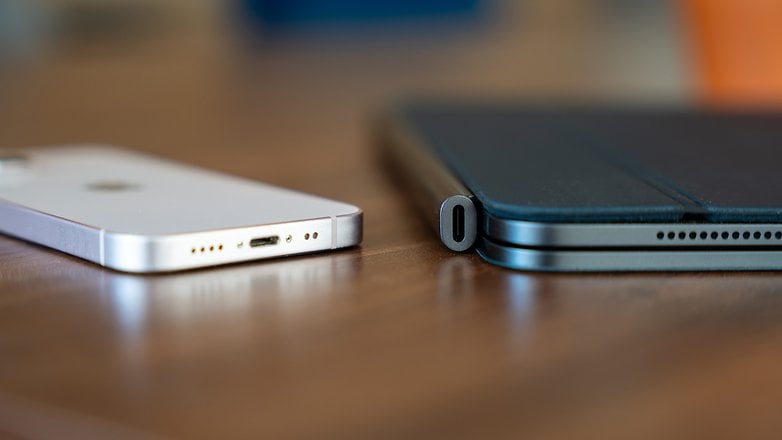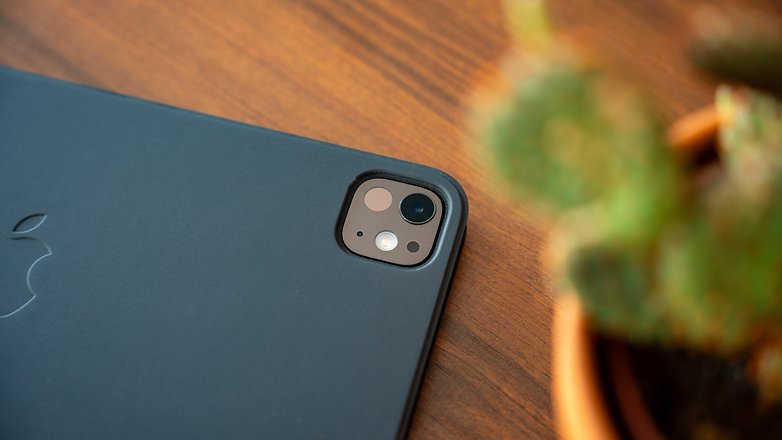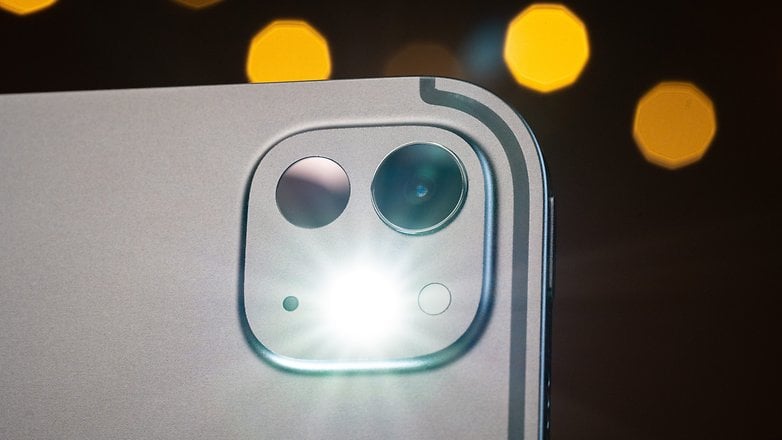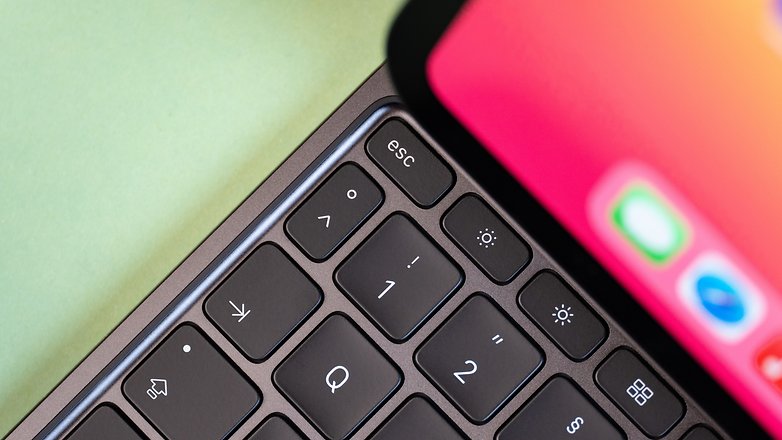
It’s been around a year and a half since Apple last updated its iPad Pro range. And although Apple said at the presentation that this year’s revisions were the biggest refresh since the iPad has been around, the new design is not noticeable at first glance. When the iPad is switched off in front of you, you probably don’t even notice where Apple has actually made changes.
One person’s joy, another person’s sorrow: the front camera is finally in the right place, but…
The redesign of the new iPad Pro has resulted in some remarkable changes. One overdue—and at the same time important—change is that the front camera has moved from the narrow side of the tablet to the top and wide side. Previously, conference calls with the iPad were only possible from very strange-looking angles.

Now the camera has finally moved to the supposedly correct position. You might ask yourself why Apple has taken so much time here. The fact that Apple wasn’t rushing at this point is probably mainly because the engineers had to redesign the entire interior of the iPad. This is because the charging device for the Apple Pencil was previously located where the camera was—and could no longer be installed in this form.
As a result, all old Pencils no longer work with the new iPads Air and Pro. Conversely, the new Apple Pencil Pro will not work with older iPads either. So if you want to enjoy the new menu, which can be opened with the new squeeze function of the Apple Pro Pencils, you have to buy one of the new iPads.
You can’t get any thinner—unless it’s bad canteen coffee
If Apple’s engineers have to get to work on the inside, they have also dared to tackle the iPad chassis directly. The result is a damn thin iPad. Apple even says that it is the thinnest Apple product ever—even thinner than the iPod nano.

The small 11-inch iPad Pro measures just 5.3 millimeters thick and is a whole 0.6 millimeters thinner. And the large 13-inch iPad is only 5.1 millimeters thick. Or rather thin.
But is it also sturdy, you may ask? We remember: with the iPhone 6 Plus, the phone could bend if you had it in your back pocket. Those days are gone once and for all. I did the bend test—admittedly not with my absolute last ounce of strength. No chance of bending anything here—although I can’t think of any situation where an iPad could accidentally bend at all.
Of course, the iPad Pro is not only thinner, but also about a large chocolate bar lighter. This is particularly noticeable when holding it for longer periods of time. Compared to the old iPads, it feels much more comfortable if you want to hold the tablet in your hand for longer to watch a movie, for example.
Better safe than sorry: the iPad Pro has two displays at once
One OLED display is good. Two OLED displays are better. But don’t worry: Apple wasn’t interested in the principle of “Never mind! The main thing is more!” but rather “a lot helps a lot.” For the first time, Apple is installing an OLED panel in an iPad and using two displays positioned exactly on top of each other.
Apple calls this technology “Tandem OLED,” which is primarily intended to ensure a brighter screen. This means that the iPad Pro panels should shine about twice as brightly as a single OLED. Just for the sake of completeness, Apple calls its new displays Ultra Retina XDR.
The Ultra Retina XDR significantly enhances the iPad Pro. It has a wonderful color reproduction, the colors are strong and rich and the black is really black compared to LCDs. Of course, the display also supports promotion—a dynamic refresh rate of up to 120 Hertz.
When I compare the iPad Pro display with my Studio Display, on which I am currently writing this short test, the differences are not that great. Except for the screen size, of course.

Apple M4: The iPad Pro is probably the fastest PC right now
As I already wrote about the displays: A lot helps a lot. While I would fully agree with this when it comes to the tandem display, it’s a slightly different story when it comes to the chip. This year, Apple has opted for a very unusual move and directly introduced a new chipset during the iPad presentation. Apple had only unveiled the M3 in October 2023 and caused quite a surprise with the early introduction of the chip.
There are probably several reasons for the introduction of the new chipset: Firstly, the M4 is produced using an improved 3 nm technology, which allows for more yield per wafer. This reduces production costs. Secondly, the M4 is significantly more powerful and the WWDC with many new functions is just around the corner.
We expect Apple to really catch up, especially in the area of AI, which could possibly also require computing power for on-device operations. And thirdly, the new tandem display also places special demands on the chip responsible, so Apple has probably opted for this unusual approach.
But the question remains: Who exactly needs the kind of computing power in a tablet that the M4 offers us? There will certainly be professionals who have a lot to do with video editing or music production and sometimes want to change a few things on their project on the train or quickly on the go. At first glance, however, the iPad Pro certainly seems to be bursting with power.
But hand on heart. Better this way than the other way around. Especially as the M4 also comes with a big increase in energy efficiency and, according to Apple, should consume up to 50% less power throughout the day. This means that the tablet should ultimately be able to run for longer without additional power.
Things you will have to do without in the future
I didn’t actually want to write this headline in such a negative way. Personally, I can not only understand Apple’s decision to do without some things in the future, I can even approve of it.
Firstly, there is the camera module of the iPad Pro, which has not changed visually but has nevertheless become smaller. Apple has done away with the ultra-wide-angle camera this year. What remains is the 12-megapixel wide-angle camera. I assume that Apple has analyzed and determined that nobody really takes photos with the iPad.
Instead, the Truetone flash now also works adaptively and should help to scan documents better with the iPad.

On the other hand, the SIM card slot has disappeared on the 5G models. I’ll be honest: I love eSIM. Nothing is easier, faster and saves so many nerves in this context. But for people who want to go abroad or have one of the providers that don’t yet offer eSIMs, unpacking the new iPad Pro could be a sad afternoon.
And there’s something else missing: Apple has recently done away with the familiar Apple stickers—a fact that many people will probably have to come to terms with. At least, you can still pick one up free of charge from the Apple Store if you wish.
However, the power adapter is now also missing. Instead, only a USB-C cable is included. I would like to emphasize at this point that I explicitly approve of and support this—after all, I can no longer count the number of unused USB-C power adapters in my home. But if you’re not like me, you might be wide-eyed at first.
New accessories can do more and feel better
My headline is not quite right, or rather not quite accurate. The new Apple Pencil Pro doesn’t look any different from its predecessor. Instead, it now comes with haptic feedback when you squeeze it and opens a new menu in the Notes app where you can quickly select pens, colors and other things. There is also a new sensor that can detect when you turn the Pencil. This allows a number of nice new functions to be displayed.
The new Magic Keyboard hasn’t changed that much visually either. The bend that makes the tablet “float” starts earlier and makes the iPad Pro stand a little straighter. What feels really cool is the new aluminum casing. Unfortunately, this is only on the inside. Unfortunately, it is still covered in plastic on the outside. The touch panel now also offers haptic feedback. All in all, you get more and more of a real “MacBook” feeling when working with the iPad Pro.

The Apple Pencil Pro is priced at $129. The Magic Keyboard costs $299 for the 11-inch and 13-inch iPads.
Conclusion: Completely over the top for me. But unfortunately so cool.
I’ll be honest. I’ll probably never be able to get the full power out of the M4 chip. Although I connected the iPad here today to my Studio Display via Thunderbolt (which only works with the Pro version) and was able to work almost like I would with a Mac, the power that the iPad Pro offers me is almost pearls before swine.
I mean that in the very best sense, by the way. Of course, it’s reassuring to know that I could also use the iPad Pro to carry out complicated and computationally intensive video editing. The fact is, however, that in the end I prefer to work with my stationary Mac at my fixed workstation.
And yet, I’ve been traveling almost exclusively with an iPad Pro for several years now. The tablet is superior to a laptop in so many ways when traveling: I open it up, and it’s ready to go! The internet is connected, I can type on the keyboard or navigate with my fingers. It has an impressive battery life and allows me to focus completely on what I’m doing.
And here we have already arrived at the Achilles heel of the iPad Pro. It costs as much as a fully-fledged computer and delivers the same performance. But the often bulky iPadOS is likely to take the joy out of daily work for many people. Please don’t get me wrong here. You can do virtually everything with an iPad Pro that you can do with a Mac. Unfortunately, it just doesn’t feel quite as comfortable.
In the end, my conclusion is that the iPad Pro feels like a MacBook, but for most people it won’t feel like one when working. That’s a question of habit. However, if you were to ask my daughter Mia, she would say the opposite. For four years, the iPad Pro has been her only computer, which she uses to do everything for school and A-levels. She doesn’t miss anything, and I understand her. But others won’t be able to do without a stationary computer or a laptop. Unfortunately, iPadOS is simply not made for that.
Nevertheless, the iPad Pro has picked me up more this year than it has for a long time. It has become so pleasantly light and thin, and the new display in particular makes a huge difference.
So what should you buy now if you want to buy an Apple tablet? If you are looking for a tablet for the loo, couch and bed, as well as for simple work, then I recommend the normal iPad. If you want a powerful iPad that’s like an extended, mobile workbench for your normal workplace when you’re traveling, then the iPad Air is perfect. And if you are a photographer, content creator or videographer —then the iPad Pro is the right choice.
In the end, unfortunately, the iPad Pro really feels so cool that I, personally, would have let my gut, not my head, decide in the end.
So if you meet me on the train at some point, don’t be surprised to see an iPad Pro in front of me.






